By Shawn Eells, UnitedHealth Group, Society Member and Level III Candidate
Was just one piece of career advice shared by Dean Junkans at the recent society luncheon titled: Leadership and Career Reflections from Two Just-Retired Industry Execs. The speakers were Howard Bicker, retired Executive Director from the Minnesota Board of Investment and Dean Junkans, CFA, retired Chief Investment Officer of Wells Fargo Wealth, Brokerage and Retirement. The event was well attended by society members and guests, and rightfully so. Audience members were treated to a noon hour of humor, humbleness and career advice from two recently retired veterans of the investment industry.
Howard Bicker kicked off the event reflecting on his career, describing the constituents he served while leading a public investment plan, the politics he encountered, and provided advice for others answering to governing bodies: present the facts, speak in plain English and be honest. Other investing wisdom shared by Mr. Bicker: keep it simple, manage costs, avoid chasing returns, and invest with conviction, i.e. make meaningful allocations to asset classes.
Dean Junkans discussed the importance of filtering out the noise and sidestepping the short-termism promoted in the media while sticking to long-term investment strategies. When asked about career advice, he responded with three important attributes: be valuable, adaptable and easy to work with. And for those aspiring to be future leaders in the investment industry? Lead from the heart, not the brain, and practice your storytelling.
The event highlighted differing opinions from two distinct investment roles. That’s what makes a market. For those wondering, “start well and end well” refers to building your brand early in your career and resisting the urge to coast into retirement. Good advice for the young and old.





